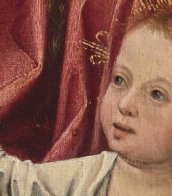sunrise

Daniel Graham was an American visual artist, writer, and curator in the writer-artist tradition. In addition to his visual works, he published a large array of critical and speculative writing that spanned the spectrum from heady art theory essays, reviews of rock music, Dwight D. Eisenhower's paintings, and Dean Martin's television show. His early magazine-based art predates, but is often associated with, conceptual art. His later work focused on cultural phenomena by incorporating photography, video, performance art, glass and mirror installation art structures, and closed-circuit television.


Roy Fox Lichtenstein, an American icon of the Pop Art movement, is celebrated for his comic strip-inspired art. Born in 1923 in New York City, Lichtenstein's journey into the art world was marked by various phases, evolving from Cubism and Abstract Expressionism to the distinctive Pop Art style he is renowned for.
Roy Lichtenstein's artistic career gained momentum in the 1960s, a period during which he embraced the comic strip as his primary source of inspiration. His pioneering use of Ben-Day dots, a technique borrowed from commercial printing, became his signature style, bringing a new visual language to fine art. His approach transformed mundane subjects from popular culture into compelling fine art, challenging traditional notions of artistry.
Among his most notable works, "Drowning Girl" (1963), displayed at the Museum of Modern Art in New York, exemplifies his iconic style with its bold lines, vivid colors, and Ben-Day dots. This piece, along with others like "Look Mickey" and "Whaam!", played a critical role in establishing Pop Art as a major art movement, contrasting starkly with the Abstract Expressionism prevalent at the time.
Roy Lichtenstein's art was not just limited to canvas; he explored multiple media, showcasing his versatility. His shift to Pop Art marked a significant turn in his career, bringing him fame and controversy alike. His works, often based on comic strips and advertisements, were both a parody and homage to the mass-produced, consumerist culture of his time.
For art collectors and experts, Lichtenstein's works offer a fascinating glimpse into a transformative era in art history. His approach to Pop Art remains influential, and his works are celebrated worldwide for their innovative and provocative style.
Interested in staying updated on sales and auction events featuring Roy Lichtenstein's works? Sign up for our updates. We provide straightforward, no-nonsense information on the latest in art sales and auctions related to Lichtenstein.


Roy Fox Lichtenstein, an American icon of the Pop Art movement, is celebrated for his comic strip-inspired art. Born in 1923 in New York City, Lichtenstein's journey into the art world was marked by various phases, evolving from Cubism and Abstract Expressionism to the distinctive Pop Art style he is renowned for.
Roy Lichtenstein's artistic career gained momentum in the 1960s, a period during which he embraced the comic strip as his primary source of inspiration. His pioneering use of Ben-Day dots, a technique borrowed from commercial printing, became his signature style, bringing a new visual language to fine art. His approach transformed mundane subjects from popular culture into compelling fine art, challenging traditional notions of artistry.
Among his most notable works, "Drowning Girl" (1963), displayed at the Museum of Modern Art in New York, exemplifies his iconic style with its bold lines, vivid colors, and Ben-Day dots. This piece, along with others like "Look Mickey" and "Whaam!", played a critical role in establishing Pop Art as a major art movement, contrasting starkly with the Abstract Expressionism prevalent at the time.
Roy Lichtenstein's art was not just limited to canvas; he explored multiple media, showcasing his versatility. His shift to Pop Art marked a significant turn in his career, bringing him fame and controversy alike. His works, often based on comic strips and advertisements, were both a parody and homage to the mass-produced, consumerist culture of his time.
For art collectors and experts, Lichtenstein's works offer a fascinating glimpse into a transformative era in art history. His approach to Pop Art remains influential, and his works are celebrated worldwide for their innovative and provocative style.
Interested in staying updated on sales and auction events featuring Roy Lichtenstein's works? Sign up for our updates. We provide straightforward, no-nonsense information on the latest in art sales and auctions related to Lichtenstein.




















Karl Hauptmann was a German landscape painter who specialised in mountain views.


Attilio Pratella was an Italian marine and landscape painter.
Attilio Pratella received his first professional skills at the Trisi College, continued his studies at the Bologna Academy of Fine Arts and at the Academy of Fine Arts in Naples. His first paintings received positive feedback from the juries of exhibitions.
The artist executed miniature Neapolitan views for tourists and made sketches of paintings of products of the ceramic factory of the Cacciapoti brothers. After moving to the Neapolitan neighborhood of Vomero, Pratella began to paint views of the picturesque surroundings, the Gulf of Naples and Vesuvius. Soon a group of Vomeresi ("Vomeristi") formed around him, and the neighborhood where he lived gradually became an entire colony of artists.
In addition to Neapolitan landscapes, the artist created cityscapes of Paris and other European cities. In 1899 Attilio Pratella participated in the Paris Salon and received great recognition. Today his works are in the collections of the Museo del Capodimonte and the Galleria dell'Arte Ricci Oddi.













![Orbital panorama at Sunrise [Mosaic]; Sunrise over the center of the Moon’s nearside; farside horizon over craters Heaviside and Keeler, May 18-26, 1969](/assets/image/picture_1219569/7885f/6ca1a0e1ccac9a7fd2aa5122b7174c941604656800jpg__fix_374_244.jpeg)
![Orbital panorama at Sunrise [Mosaic]; Sunrise over the center of the Moon’s nearside; farside horizon over craters Heaviside and Keeler, May 18-26, 1969](https://veryimportantlot.com/assets/image/picture_1219569/7885f/6ca1a0e1ccac9a7fd2aa5122b7174c941604656800jpg__fix_374_244.jpeg)











![Moonscapes [Large Formats]: Sunrise over Crater Tycho; Crater Hyginus; the Moon Alps; eastern central peak of Crater Copernicus, August 1967](/assets/image/picture_1219002/c23df/311429e12dda51c62e163dc18ee921b11604656800jpg__fix_374_244.jpeg)
![Moonscapes [Large Formats]: Sunrise over Crater Tycho; Crater Hyginus; the Moon Alps; eastern central peak of Crater Copernicus, August 1967](https://veryimportantlot.com/assets/image/picture_1219002/c23df/311429e12dda51c62e163dc18ee921b11604656800jpg__fix_374_244.jpeg)
![Telephoto panorama of Ariadaeus Rille [Mosaic]; Crater Godin at Sunrise; Hyginus Rille at the terminator, May 18-26, 1969](/assets/image/picture_1219553/0245c/dd5a935f3da083fe3157ebe60689bf691604656800jpg__fix_374_244.jpeg)
![Telephoto panorama of Ariadaeus Rille [Mosaic]; Crater Godin at Sunrise; Hyginus Rille at the terminator, May 18-26, 1969](https://veryimportantlot.com/assets/image/picture_1219553/0245c/dd5a935f3da083fe3157ebe60689bf691604656800jpg__fix_374_244.jpeg)
















![[Large Formats] The Taurus-Littrow landing site and Sunrise over the Apennine and Caucasus mountains, taken by Fairchild metric camera, December 7-19, 1972](/assets/image/picture_1221715/68b71/3a0ae1e676c34fce771073e9491d78311604656800jpg__fix_374_244.jpeg)
![[Large Formats] The Taurus-Littrow landing site and Sunrise over the Apennine and Caucasus mountains, taken by Fairchild metric camera, December 7-19, 1972](https://veryimportantlot.com/assets/image/picture_1221715/68b71/3a0ae1e676c34fce771073e9491d78311604656800jpg__fix_374_244.jpeg)


















